
Project by Christina, Eileen, and Katie
 Quick Facts: The Olympics have evolved substantially over the centuries. The rules, requirements, frequency and more have undergone significant change since they were first held in Olympia, Greece in the year 776 B.C.E. It is believed Olympics were held earlier than that as well although nothing was recorded. During ancient times they were held every four years in the summer and always in the same place. Now, the Olympics are held in different countries every time. Also, in modern times there are winter and summer Olympics which each occur ever 4 years. However, they are not held in the same year as they once were. Now, two years after the Summer Olympics are held, the Winter Olympics are held, and two years after that are the Summer Olympics, and so on. Winter Olympics were never held in Ancient Greece. The Winter Games today have sports such as figure skating, skiing, and bobsledding. Today, a torch is lit at Olympia to symbolize the ancient Olympics. Various athletes carry this torch throughout the country the Olympics are being held in until they reach the main stadium. These are only some of the differences and similarities between the ancient and the modern games. A great deal of the ancient games still applies to the modern and yet so much has changed.
Quick Facts: The Olympics have evolved substantially over the centuries. The rules, requirements, frequency and more have undergone significant change since they were first held in Olympia, Greece in the year 776 B.C.E. It is believed Olympics were held earlier than that as well although nothing was recorded. During ancient times they were held every four years in the summer and always in the same place. Now, the Olympics are held in different countries every time. Also, in modern times there are winter and summer Olympics which each occur ever 4 years. However, they are not held in the same year as they once were. Now, two years after the Summer Olympics are held, the Winter Olympics are held, and two years after that are the Summer Olympics, and so on. Winter Olympics were never held in Ancient Greece. The Winter Games today have sports such as figure skating, skiing, and bobsledding. Today, a torch is lit at Olympia to symbolize the ancient Olympics. Various athletes carry this torch throughout the country the Olympics are being held in until they reach the main stadium. These are only some of the differences and similarities between the ancient and the modern games. A great deal of the ancient games still applies to the modern and yet so much has changed.
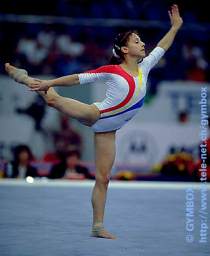 The Sports: In the Ancient Greek Olympics there were only ten sports while in modern day Olympics there are substantially more. Still, as in the modern games, they slowly added more. In the ancient games they had 4 running races, equestrian racing, wrestling, boxing, pancratium, pentathlon, and chariot races. In Modern Day Olympics they have gymnastics, triathlon, cycling, fencing, and volleyball to name a few, and of course there are all the winter sports. However, the sports of chariot races and pancratium have been discontinued.
The Sports: In the Ancient Greek Olympics there were only ten sports while in modern day Olympics there are substantially more. Still, as in the modern games, they slowly added more. In the ancient games they had 4 running races, equestrian racing, wrestling, boxing, pancratium, pentathlon, and chariot races. In Modern Day Olympics they have gymnastics, triathlon, cycling, fencing, and volleyball to name a few, and of course there are all the winter sports. However, the sports of chariot races and pancratium have been discontinued.
*ANCIENT SPORTS*
Boxing: ....
The sport of boxing was added to the ancient games in the 23rd Olympiad during the year 688 B.C. E. It was very different from what we see today. First the competitors wore strips of leather tied about their palms and had no gloves. Also, boxing took place in open space, not in a ring, and they did not break the fighters into different categories by weight. Punches were mostly thrown to the head and not the body as in today's sport and importantly, there were no rounds or breaks. The fight continued until one of the men could not fight back or was unconscious. If the fight continued for a long period, the judge could ask for a "climax". During such times, punches were exchanged and the defender could not protect himself. This brought about an often brutal but quicker end to the match. That which remains the same from the ancient games is that boxing still requires a one on one competition, overseen by judges. Also, the goal is the same, to knock out or disable your opponent by as many blows as is needed.
Wrestling: ...Wrestling may have evolved from the original Greek games but it is very different today. In ancient Greece, there were two forms of wrestling. First there was upright wrestling. During this competition the combatants stood upright and the winner was the man who could throw the other to the earth. This was a sport of skill and grace rather than brute force. It was also part of the ancient Greek Pentathlon. The judges declared a looser if knees or the man's hips, back or shoulders touched the ground. It was held in a sandpit unlike the mats used today. That which is the same is that there can be no illegal moves such as hitting, gouging or twisting of hands, feet, arms or legs during the event.
Ground wrestling was very different as well. During this event hitting and kicking were allowed. It seems almost like boxing and wrestling combined because just like boxing, the end of the match occurs when the looser admits defeat or is disabled. This event was part of the Pankration, an event that is no longer a part of the modern Olympics.
Pancration:...The name of this event meant all-powerful. It is a combination of wrestling and boxing. In the ancient Olympics, there were very few rules in this fight. Everything was allowed including biting, dislocating joints and gouging of each other's eyes. This event was so brutal that an occasional contestant would not survive the event. This same fact however, also made the Pankration the most popular of the sports at the ancient Olympics.
Pentathlon: In ancients Greece the Pentathlon was made up of five different events which were discus, javelin, long jump, running, and wrestling. One important similarity between this event in ancient times and that of modern day is that finishing in second or third place mattered in the individual events. This was because the finishes in all the five events needed to be combined to determine a winner. The first event in ancient times was the discus throw. This is perhaps one of the least changed of the sports in all the years that have passed. Next was the long jump. Like the discus throw this was done with flute music being played in the background. Another difference of note is that they would carry weights in their hands called halteres. It is also believed that for a while in ancient Greece, they may have jumped a series of five jumps in a row for there is a recorded jump of 52 feet in the 664 Olympic Games. The javelin of old is similar to today's event except they competed not only for distance but there was a competition for accuracy as well. Also, the man could use a leather-throwing loop on the pole. The fourth event was the stade race. This mirrors the sprint races of today. At the signal, the men would race the length of the stadium to determine who was the fastest. The last event of the ancient pentathlon was upright wrestling as was discussed above. This event is no longer a part of the modern Olympic pentathlon.
Chariot Races: Chariot racing is no longer a part of the Olympics and is an event which is identified strongly with ancient Greece. There were four horses per chariot and they would race 24 times around two poles at either end of a rectangular area that was about twice the length of the stadium. There was no direction given so there would often be head-on collisions. This was a sport that did not need the strength and endurance of the others and may have been added to give out of shape nobleman a place to compete.
Equestrian Races: Another horse race was part of the ancient Olympics. This was unlike today's Olympics and yet very much like other horse races of modern day. The owner of the horse hired a jockey to ride the animal. It was even possible for a rider-less horse to win as long as it was the fastest. This was a competition more about horse training and breeding, both very important to the Greeks, than about any human athletics.
Running Events: In ancient Greece the Olympics had three foot races. First was the long distance Dolichos. Second was the Stade Race which was a short distance sprint and the third was the Diaulos which is known as the double Stade Race as it was exactly twice its length. The Dolichos is similar to today's marathon but is much shorter. It was about two and one quarter miles long. Also, it was run within the stadium and not through the surrounding countryside. The Stade Race and the Dolichos were run much like today's shorter Olympic foot races with one important exception, the runners were nude as were many of the sports events in that time.

 Opening Ceremonies and Pre-Olympics: The opening ceremonies in Ancient Greece were nothing like they are today. In Ancient Greece they had a Festival of Heraia, Zeus' wife. It was nothing completely separate though like the Opening Ceremonies are today. It was just simply a festival, which continued throughout the games. Today, we have huge ceremonies where famous performers sing and dance, people were very amazing and intricate costumes, and there are usually fireworks or something similar to that. The Opening Ceremonies today are quite commercial as well. Ancient Greece did not have the extensive celebration of an Opening Ceremony. Athletes trained for ten months and they were examined by a ten member panel assessed them. Today athletes trained their whole lives and go through a series of drug tests before they can compete. In the Ancient Greek games as well as today athletes have swear in oath to play fairly.
Opening Ceremonies and Pre-Olympics: The opening ceremonies in Ancient Greece were nothing like they are today. In Ancient Greece they had a Festival of Heraia, Zeus' wife. It was nothing completely separate though like the Opening Ceremonies are today. It was just simply a festival, which continued throughout the games. Today, we have huge ceremonies where famous performers sing and dance, people were very amazing and intricate costumes, and there are usually fireworks or something similar to that. The Opening Ceremonies today are quite commercial as well. Ancient Greece did not have the extensive celebration of an Opening Ceremony. Athletes trained for ten months and they were examined by a ten member panel assessed them. Today athletes trained their whole lives and go through a series of drug tests before they can compete. In the Ancient Greek games as well as today athletes have swear in oath to play fairly.
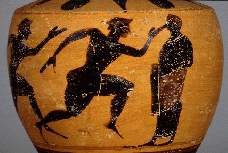 Competitors: In Ancient Greece, Greek male citizens competed against each other in the ten sports. They competed nude and put olive oil on themselves. The competitors would pray to Hermes (a god) for speed. Today, people from all nations come to compete in various sports. Countries wear different types of uniform depending on the sport which show the athlete's flag colors.
Competitors: In Ancient Greece, Greek male citizens competed against each other in the ten sports. They competed nude and put olive oil on themselves. The competitors would pray to Hermes (a god) for speed. Today, people from all nations come to compete in various sports. Countries wear different types of uniform depending on the sport which show the athlete's flag colors.
Women in the Olympics: Women were not allowed to compete in the Ancient Olympics games and were forbidden to watch. If I woman was caught watching the Olympic games, she would be killed. In modern Olympics, women are allowed to watch and/or compete Between 1940 and 1948, there was a large increase of women competitors in the Olympic games. There are many famous women athletes today such as Cathy Freeman, Marion Jones, Olga Korbut, and Mary Lou Retton to name a few.
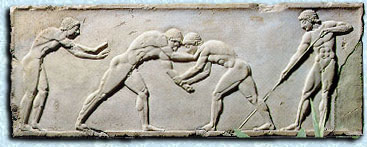
 What Athletes Were Awarded: Today athletes are awarded gold for first, silver for second, and bronze for a third place finish. They also receive flowers and fame. Many Olympic medallists go on to be in commercials, magazines, write books, and even act in TV shows and movies. In the Ancient Times the athlete's wreath of olive leaves that was worn on their head. Their athletes were also awarded a branch from a wild olive tree. The branch was cut off the olive tree with a golden handled knife. The winning athlete would give public thanks to Zeus and the Gods would favor the town of a winning athlete.
What Athletes Were Awarded: Today athletes are awarded gold for first, silver for second, and bronze for a third place finish. They also receive flowers and fame. Many Olympic medallists go on to be in commercials, magazines, write books, and even act in TV shows and movies. In the Ancient Times the athlete's wreath of olive leaves that was worn on their head. Their athletes were also awarded a branch from a wild olive tree. The branch was cut off the olive tree with a golden handled knife. The winning athlete would give public thanks to Zeus and the Gods would favor the town of a winning athlete.
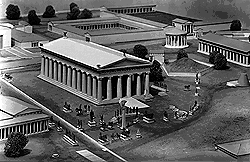
Captions: The first picture shows an entrance of a stadium in Olympia. The second picture is of Romanian gymnast Andreea Raducan who competed in Women's artistic gymnastics (Sydney 2000). The third picture is a drawing of a chariot race competition. The fourth picture shows Australian girl, Nikki Webster, flying above Australian 'aboriginals' during the Sydney 2000 Opening Ceremonies. The fifth picture is a pot, which shows Greek's in a running competition. The sixth picture is a stone carving which shows what wrestling would have looked like in the Ancient Games. The seventh picture is of again, Romanian Andreea Raducan with a gold medal. The eighth picture is of Zeus' temple in Athens, Greece. Zeus was the main god that was worshipped.
LINKS:
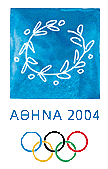 Ancient Sports of the Olympic Games | Olympic Facts | The Real Story of the Ancient Olympic Games | Ancient Olympic Games | The Greek Athletic Games | Ancient Greece.com: Olympics| Olympics Through Time
Ancient Sports of the Olympic Games | Olympic Facts | The Real Story of the Ancient Olympic Games | Ancient Olympic Games | The Greek Athletic Games | Ancient Greece.com: Olympics| Olympics Through Time
Christina's Ancient and Medieval Homepage | Eileen's Ancient and Medieval Homepage | Katie's Work Page
Bibliography


 Quick Facts: The Olympics have evolved substantially over the centuries. The rules, requirements, frequency and more have undergone significant change since they were first held in Olympia, Greece in the year 776 B.C.E. It is believed Olympics were held earlier than that as well although nothing was recorded. During ancient times they were held every four years in the summer and always in the same place. Now, the Olympics are held in different countries every time. Also, in modern times there are winter and summer Olympics which each occur ever 4 years. However, they are not held in the same year as they once were. Now, two years after the Summer Olympics are held, the Winter Olympics are held, and two years after that are the Summer Olympics, and so on. Winter Olympics were never held in Ancient Greece. The Winter Games today have sports such as figure skating, skiing, and bobsledding. Today, a torch is lit at Olympia to symbolize the ancient Olympics. Various athletes carry this torch throughout the country the Olympics are being held in until they reach the main stadium. These are only some of the differences and similarities between the ancient and the modern games. A great deal of the ancient games still applies to the modern and yet so much has changed.
Quick Facts: The Olympics have evolved substantially over the centuries. The rules, requirements, frequency and more have undergone significant change since they were first held in Olympia, Greece in the year 776 B.C.E. It is believed Olympics were held earlier than that as well although nothing was recorded. During ancient times they were held every four years in the summer and always in the same place. Now, the Olympics are held in different countries every time. Also, in modern times there are winter and summer Olympics which each occur ever 4 years. However, they are not held in the same year as they once were. Now, two years after the Summer Olympics are held, the Winter Olympics are held, and two years after that are the Summer Olympics, and so on. Winter Olympics were never held in Ancient Greece. The Winter Games today have sports such as figure skating, skiing, and bobsledding. Today, a torch is lit at Olympia to symbolize the ancient Olympics. Various athletes carry this torch throughout the country the Olympics are being held in until they reach the main stadium. These are only some of the differences and similarities between the ancient and the modern games. A great deal of the ancient games still applies to the modern and yet so much has changed.
 The Sports: In the Ancient Greek Olympics there were only ten sports while in modern day Olympics there are substantially more. Still, as in the modern games, they slowly added more. In the ancient games they had 4 running races, equestrian racing, wrestling, boxing, pancratium, pentathlon, and chariot races. In Modern Day Olympics they have gymnastics, triathlon, cycling, fencing, and volleyball to name a few, and of course there are all the winter sports. However, the sports of chariot races and pancratium have been discontinued.
The Sports: In the Ancient Greek Olympics there were only ten sports while in modern day Olympics there are substantially more. Still, as in the modern games, they slowly added more. In the ancient games they had 4 running races, equestrian racing, wrestling, boxing, pancratium, pentathlon, and chariot races. In Modern Day Olympics they have gymnastics, triathlon, cycling, fencing, and volleyball to name a few, and of course there are all the winter sports. However, the sports of chariot races and pancratium have been discontinued.

 Opening Ceremonies and Pre-Olympics: The opening ceremonies in Ancient Greece were nothing like they are today. In Ancient Greece they had a Festival of Heraia, Zeus' wife. It was nothing completely separate though like the Opening Ceremonies are today. It was just simply a festival, which continued throughout the games. Today, we have huge ceremonies where famous performers sing and dance, people were very amazing and intricate costumes, and there are usually fireworks or something similar to that. The Opening Ceremonies today are quite commercial as well. Ancient Greece did not have the extensive celebration of an Opening Ceremony. Athletes trained for ten months and they were examined by a ten member panel assessed them. Today athletes trained their whole lives and go through a series of drug tests before they can compete. In the Ancient Greek games as well as today athletes have swear in oath to play fairly.
Opening Ceremonies and Pre-Olympics: The opening ceremonies in Ancient Greece were nothing like they are today. In Ancient Greece they had a Festival of Heraia, Zeus' wife. It was nothing completely separate though like the Opening Ceremonies are today. It was just simply a festival, which continued throughout the games. Today, we have huge ceremonies where famous performers sing and dance, people were very amazing and intricate costumes, and there are usually fireworks or something similar to that. The Opening Ceremonies today are quite commercial as well. Ancient Greece did not have the extensive celebration of an Opening Ceremony. Athletes trained for ten months and they were examined by a ten member panel assessed them. Today athletes trained their whole lives and go through a series of drug tests before they can compete. In the Ancient Greek games as well as today athletes have swear in oath to play fairly.  Competitors: In Ancient Greece, Greek male citizens competed against each other in the ten sports. They competed nude and put olive oil on themselves. The competitors would pray to Hermes (a god) for speed. Today, people from all nations come to compete in various sports. Countries wear different types of uniform depending on the sport which show the athlete's flag colors.
Competitors: In Ancient Greece, Greek male citizens competed against each other in the ten sports. They competed nude and put olive oil on themselves. The competitors would pray to Hermes (a god) for speed. Today, people from all nations come to compete in various sports. Countries wear different types of uniform depending on the sport which show the athlete's flag colors. 
 What Athletes Were Awarded: Today athletes are awarded gold for first, silver for second, and bronze for a third place finish. They also receive flowers and fame. Many Olympic medallists go on to be in commercials, magazines, write books, and even act in TV shows and movies. In the Ancient Times the athlete's wreath of olive leaves that was worn on their head. Their athletes were also awarded a branch from a wild olive tree. The branch was cut off the olive tree with a golden handled knife. The winning athlete would give public thanks to Zeus and the Gods would favor the town of a winning athlete.
What Athletes Were Awarded: Today athletes are awarded gold for first, silver for second, and bronze for a third place finish. They also receive flowers and fame. Many Olympic medallists go on to be in commercials, magazines, write books, and even act in TV shows and movies. In the Ancient Times the athlete's wreath of olive leaves that was worn on their head. Their athletes were also awarded a branch from a wild olive tree. The branch was cut off the olive tree with a golden handled knife. The winning athlete would give public thanks to Zeus and the Gods would favor the town of a winning athlete. 
 Ancient Sports of the Olympic Games | Olympic Facts | The Real Story of the Ancient Olympic Games | Ancient Olympic Games | The Greek Athletic Games | Ancient Greece.com: Olympics| Olympics Through Time
Ancient Sports of the Olympic Games | Olympic Facts | The Real Story of the Ancient Olympic Games | Ancient Olympic Games | The Greek Athletic Games | Ancient Greece.com: Olympics| Olympics Through Time